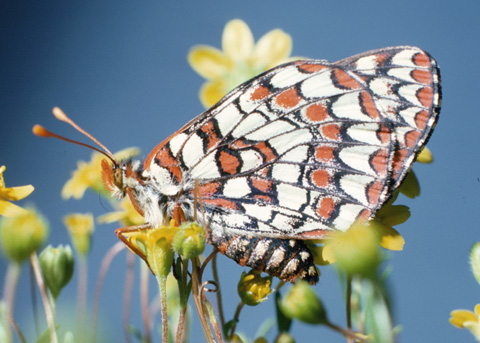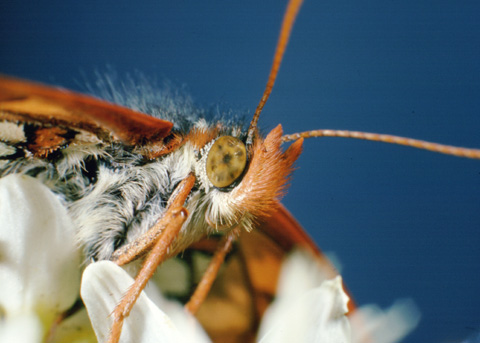
|
Quino Checkerspot Butterfly Euphydryas editha quino Lepidoptera: Nymphalidae © Peter J. Bryant. |

|
 |
|
Characteristics: Dorsal wing checkered with dark brown, reddish, and yellowish spots. Forewing length: 21-27 mm. Similar Species: Also known as Wright's Checkerspot or Wright's Euphydryas, Euphydryas editha wrighti. Chlosyne gabbii could be mistaken for this species. The shape of the forewing is one distinguishing character. Gabb's Checkerspot is also generally smaller in size, possessing orange instead of red markings. The Chalcedon Checkerspot (Euphydryas chalcedona) also somewhat resembles this species. Habitats, Behavior: This rare butterfly occurs in localized colonies, always closely associated with the larval foodplant. It is a slow flyer, easy to capture. The adults are said by Theodore Hower to be especially fond of the blossoms of Chia (Salvia columbariae, Labiatae), a short mint-smelling plant with purple flowers for nectaring purposes. Other chaparral annual flowers are also visited. Distribution: Several colonies were once located in Orange County but today the species is either locally extinct or undiscovered here. Colonies were once located at Dana Point (on the bluff edge of the mesa), the Laguna Lakes (east side of Laguna Canyon Road), Hidden Ranch (Black Star Canyon hills above Hidden Ranch), and the hills north of Irvine Park. I (Larry Orsak) visited the Irvine Park locality twice in 1973 (over a three week period), the Hidden Ranch colony three times in 1974 (over a two week period) and again in 1976, and the Laguna locality area in 1974, but could not locate the colonies. James Mori's Hidden Ranch colony was located on a dome-shaped hill (see "Black Star Canyon" U. S. Geological Survey Topographical Map, 1967 edition) approximately 0.4 air mile south and slightly west of Hidden Ranch (east side of the Forest Service road). The Quino checkerspot once thrived from the Santa Monica Mountains south to northern Baja California. There are six known U.S. populations in southwestern Riverside and San Diego counties, and at least one population near Tecate, Mexico. Flight Period: One brood. The species usually flies from early March to early April. The June specimen in the Hower collection could be mislabelled. In 1975, however, possibly due to late rains, the species flew in the Gavilan Hills from late March until the middle of May. Larval Foodplant: Plantain, Plantago erecta, was utilized in Orange County; said to be of occasional occurrence in open places in chaparral and mountains (Boughey, 1968). The foodplant, when found, is often abundant, but of local occurrence. Small stands were located (1974) in the vicinity of Laguna Lakes (e.g. first canyon S of Laguna Lakes--hills S of Sycamore Flat--and also S of Laguna Lakes on E side of Laguna Canyon Road). None was found at any of the other former county editha sites which were visited. Plantago erecta grows no taller than 2 or 3 inches. I have found it growing on gradual slopes in well-drained soil. Theodore Hower states that Plantago is found in clay subsoil with a sand overlay at Dana Point and elsewhere and my observations agree with this statement. Other Remarks: Erich Walter relayed some interesting information concerning the history of the Irvine Park population. John A. Comstock and colleagues collected numerous specimens of editha at Irvine Park in 1922. Following this, the colony apparently disappeared until the late 1920's and early 1930's, although most likely this population fluctuation was not correlated with collecting of specimens. By 1934 the colony had "reappeared" and increased to its former size. Mr. Walter also mentions he and John Johnson taking a "bagful of editha from the Irvine Park colony to a suitable habitat in the Murphy Hills (west of Coyote Hills bordered by Rosecrans Avenue on the south, Beach Boulevard on the east and Imperial Highway on the north). They had hoped that the butterflies could be established at the site, but unfortunately no follow-up visits were made. After several futile searches, I am somewhat pessimistic concerning the present existence of this species in Orange County. Emmel and Emmel (1973) state "The Orange County populations (hills near Hidden Ranch, Black Star Canyon in the Santa Ana Mountains ) are perhaps the last real strongholds (of E. editha wrighti) left.... " This colony seems to have been destroyed by the 1967 fire, although John Cooper of Anaheim must be commended for his recent attempts to reestablish editha here from Gavilan Hills stock. Strong colonies are are still found in several areas in San Diego and Riverside Counties. Some lepidopterists, such as Chris Henne (Pearblossom, California) feel that editha wrighti may diapause for several years. If so, this may at least partially explain the extreme fluctuation in numbers that colonies at Irvine Park, the Gavilan Hills, and elsewhere exhibit. Conservation Status: Listed as a federally endangered species 1/16/97. From: Orsak, Larry J. (1978) "The Butterflies of Orange County, California". Published by the Center for Pathobiology, University of California, Irvine with updates added by Peter Bryant. Return to Butterflies and their larval foodplants |
|
